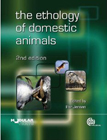
The Ethology of Domestic Animals: an introductory text
This book is a collection of articles by specialists, edited by Per Jensen, Professor of Ethology at Linköping University, Sweden, who has a particular interest in behaviour genetics.
The first six chapters of the book are a general introduction to key areas and concepts in animal behaviour, looking at behavioural genetics, domestication and evolution, physiology and behaviour, motivation, learning and cognition, social and reproductive behaviour, abnormal behaviour and welfare, and human-animal relations. Chapters seven to thirteen look at different key species of domestic animals, fowl, horses, cattle, sheep, goats, pigs, cats, dogs, and rabbits and rodents. There’s a strong emphasis on implications of current knowledge for animal welfare, whether for farm animals such as pigs and sheep, or companion animals such as cats and dogs.
The format, with the general introduction first, helps to put into perspective the articles on different species, and so highlight species-specific behaviour, and point to why species might vary in their behaviour. It’s an edited work, which allows for specialists to make their contributory chapters. John Bradshaw’s chapter on cats, for example is very interesting, and he’s much more within his area of expertise here than when he writes on dogs. A disadvantage of an edited text is that readers have to cope with different writing styles. In general, the book is clearly written, though some chapters are challenging, for example the chapter on physiology and behaviour. In contrast, the chapter on social behaviour is easy to read, and could perhaps be a little more in-depth, given that there’s so much interest in this topic.
The book was updated in 2009 for the second edition, and considerable research has been carried out since then, but even so, it gives a good basic grounding in the ethology of domestic animals, which readers can supplement with more recent articles from their specialities. The book is good value for money, for what it offers. Mills (ed) Encylopedia of Applied Animal Behaviour and Welfare (1) is meatier, but far more expensive, and doesn’t pull together broad themes in such a coherent way.
The great benefit of this book is that it brings together a lot of work in diverse fields and puts it together in a way that’s useful for anyone who has to take decisions on a range of domestic animals. It also provides useful background information for specialists in areas like anthrozoology, or in the behaviour of particular species, like dogs or cats. It’s certainly worth learning more about the ethology of farm animals if you’re involved in farming. It’s easier to care for farm animals when you’re aware of what might stress them, and what they’d prefer to do, given the opportunity. There are obvious ethical issues to do with welfare, which the book stresses. It’s also easier to avoid behavioural problems, which can be expensive to sort out, if one has an understanding of the nature of farm animals, as is true for animals we keep as pets.
Note:
- Mills, D. (ed) (2010) Applied Animal Behaviour and Welfare. Cabi, Wallingford, England


